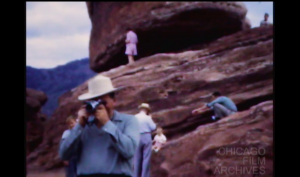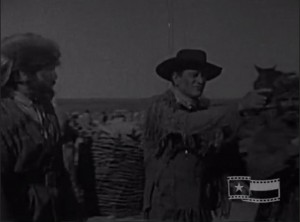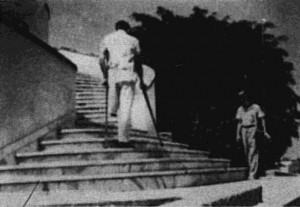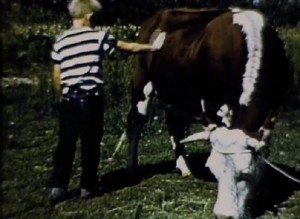
"An amateur film made by and starring the husband and wife duo, John & Evelyn Kibar. After receiving numerous travel brochures in the mail, the Kibars begin reflecting on all the possible destinations they could visit - including Colorado, Bryce Canyon National Park and Jackson Hole, Wyoming. Actual travelogue footage shot by the Kibars acts as our reflective imagery, while title cards with dialogue are dispersed throughout the film." Chicago Film Archives
"Film documents Queen Elizabeth II's visit to Toronto. Film shows crowds gathered, Queen Elizabeth II arriving at event and speaking with people" Archives of Ontario.

"“The Air Evac Story, or: Better You Should Walk?” is a humorous amateur film that spoofs the United States Air Force’s medical evacuation services. Starring members of the 14th Aeromedical Transport Squadron, the film begins at squadron headquarters at Brooks Air Force Base in San Antonio. It then follows crew members on their daily mission to transport patients, making stops in El Paso and Brackettville. While the voiceover narration commends the squadron for their professionalism, their comedic actions throughout the film tell a different story. Of particular note is a cameo by none other than John Wayne. Charles F. Curtis, a cinematography engineer with the Air Force, made the spoof with his crew around the same time that Wayne was in Brackettville shooting The Alamo (1960). Curtis helped design a working camera track system for the blockbuster film, and Wayne agreed to make a brief appearance in the Air Evac Story as thanks" Texas Archive of the Moving Image.
"Film of picturesque scenes of flowing water." Library and Archives Canada.

"The Title is taken from the opening scene of a shoeshine box busy shining shoes with the help of a small boy. On the side of the box is the price of the shine, 10¢. An episode in a series of events in which the little box is every presented. A simple, yet touching portrayal in which the audience is so carefully drawn to live those few minutes with a wonderful little boy. The film leads but does not close in on us, our emotions may move with our interpretation. The maker, Antonio Cernuda, with a display of the artist and philosopher, has earned his second Gold Medal Award" PSA Journal, Nov. 1959, 47-48.

"A documentary what will keep on film those disappearing landmarks of fond childhood memories. Members of the family reenact those wonderful memories. The children are vehicles of a flash back, at play, caring for dolls and pets. The energies of little boys and girls doing things that we may relive as we watch the Tapps' other years. A delightful family picture" PSA Journal, Nov. 1959, 47.
"A scientific expedition to Mexico for a study of the animals, reptiles and birds. Our visit for the most part is in the rural or wilderness areas but we do get into the market place and we see some of the ancient ruins. A pictorial review of a great many of species of wild life which we rarely see as many of us are afraid to visit the habitat of those creatures. The close-up photography puts the small creatures almost on our noses" PSA Journal, Nov. 1959, 48.
"A diesel followed by yesterday's steam locomotives lay the contrasts for this journey to yesterday. Rio Grande's old seam locomotive 473 takes us from Durango to Silverton, Colorado, through the wild country where enroute we see things today as they were yesterday. Throughout this trip we feel the realism of the sound accompaniment, so tastefully a part of the picture. The maker of this film was well aware of the need to include people and human interest, and it did it well" PSA Journal, Nov. 1959, 48-49.
"The Valley 8mm Club of North Hollywood has turned toward drama for its newest scenario production. A touching story of a sick mother in rather meager circumstances and in need to medical care. The youthful daughter and the druggist carry out the leading roles with effective realism. There is a remarkable accomplishment of lip sync as needed in a few places through the use of strobe-tape. The dramatic ending completely detaches us from the mother's illness" PSA Journal, Nov. 1959, 47.
"Col. Kelly took the time to use his camera effectively on an assignment in Korea where the older folks are referred to with family reverence as Papa-san and Mama-san. Here we have a review of life in Korea as an Army officer may see it. After the war there is reconstruction and training of the 4th largest standing army in the world. A country divided at the 38th parallel must live under the protection of a well-trained army, trained by U.S. personnel. A documentary-travelogue that lives all of its 25 minutes of screen time" PSA Journal, Nov. 1959, 47.
Total Pages: 299